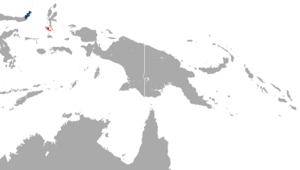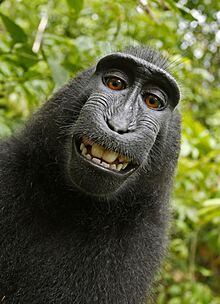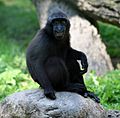Celebes crested macaque facts for kids
Quick facts for kids Celebes crested macaque |
|
|---|---|
 |
|
| Celebes crested macaque at Diergaarde Blijdorp in Rotterdam, Netherlands | |
| Conservation status | |
| Scientific classification | |
| Genus: |
Macaca
|
| Species: |
nigra
|
 |
|
| Celebes crested macaque range (blue—native, red—introduced) |
|
The Celebes crested macaque (Macaca nigra) is a special type of monkey. It's also known as the crested black macaque or black ape. These monkeys live in the rainforests of Sulawesi, an island in Indonesia. You can also find them on some smaller islands nearby. They are a kind of Old World monkey.
Contents
Meet the Celebes Crested Macaque
Locally, people call this monkey yaki or wolai. Its skin and face are completely black. It has no hair on its face, except for some white hair on its shoulders. What makes them unique are their reddish-brown eyes. This is unusual for a primate.
They have a long snout and high cheeks. A cool feature is the long tuft of hair, or crest, on top of their head. They look a bit like an ape because their tail is very short. It's only about 2 centimeters long and hard to see!
These macaques are one of the smaller macaque species. They are about 44 to 60 centimeters long. They weigh between 3.6 and 10.4 kilograms. In the wild, they usually live for about 15 to 20 years.
Where Do They Live and What Do They Eat?
The Celebes crested macaque lives in rain forests. They are active during the day. Most of their time, over 60%, is spent on the ground. They look for food and spend time with their group there. At night, they sleep in trees. They also find some food in the trees.
These monkeys mostly eat fruits. About 70% of their diet is fruit! But they also enjoy other foods. They eat leaves, buds, and seeds. Sometimes they eat fungus, small birds, or bird eggs. They also hunt insects like beetles and caterpillars. You might see them eating worms, snails, or even small lizards and frogs.
How Do They Live in Groups?
Celebes crested macaques live in social groups. These groups usually have 5 to 25 monkeys. Sometimes, very large groups can have up to 75 animals! Smaller groups have only one adult male. Bigger groups can have up to four adult males. However, there are always more adult females than males. There are usually about four females for every male.
When young adult males grow up, they have to leave their birth group. They might form groups with other young males. Later, they try to join an existing mixed-sex group. These monkeys talk to each other using different sounds and body movements. For example, showing their long canine teeth while making a face is a sign of warning.
Female macaques are pregnant for about 174 days. They usually have one baby. Babies are often born in the spring when there is more food. Young monkeys drink their mother's milk for about one year. They become fully grown in three to four years. Females mature a little faster than males.
Macaques and People

Sometimes, these macaques eat crops from farms. Because of this, some people hunt them. They are also hunted for food. Cutting down the rainforests where they live also puts them in danger.
On smaller islands near Sulawesi, like Bacan, their situation is a bit better. Fewer people live on those islands. On Sulawesi, there are an estimated 4,000 to 6,000 macaques. But on Bacan, there are many more, up to 100,000 monkeys!
Many people are working to protect these monkeys. A conservation program called Selamatkan Yaki was started. This means "Save the Yaki" in the local language. It works with local groups and other conservation groups from different countries. Zoos like Newquay Zoo and Paignton Zoo also help. They have groups of these monkeys that breed. This helps make sure the species doesn't disappear.
Since 2006, the Macaca Nigra Project has been studying these monkeys. They also work to protect them. This project is in the Tangkoko Batuangus Nature Reserve. This reserve is home to the largest group of crested macaques left in their natural home.
Even though they are in great danger, these monkeys are still hunted outside the Tangkoko reserve. They are easy to catch because they are not afraid of humans. Some local people consider them a special food.
In 2013, a wildlife filmmaker named Colin Stafford-Johnson filmed these monkeys. He spent time with them for a BBC show called Meet the Monkeys. In 2014, a photo taken by a Celebes crested macaque became very famous. It was a 'selfie' taken by the monkey itself! This led to many discussions about who owns the copyright to such a photo.
Gallery
-
Skull and a jaw bone at the Naturalis Biodiversity Center in Leiden, Netherlands
-
Skeleton in the Miguel Mendez, Malahide, Ireland
-
Two celebes macaques grooming each other at the Diergaarde Blijdorp in the Rotterdam, Netherlands
-
Juvenile celebes crested macaque at the Buffalo Zoo in Buffalo, New York
-
A celebes macaque trying to eat coconut at the Tangkoko National Park, Sulawesi, Indonesia
See also








